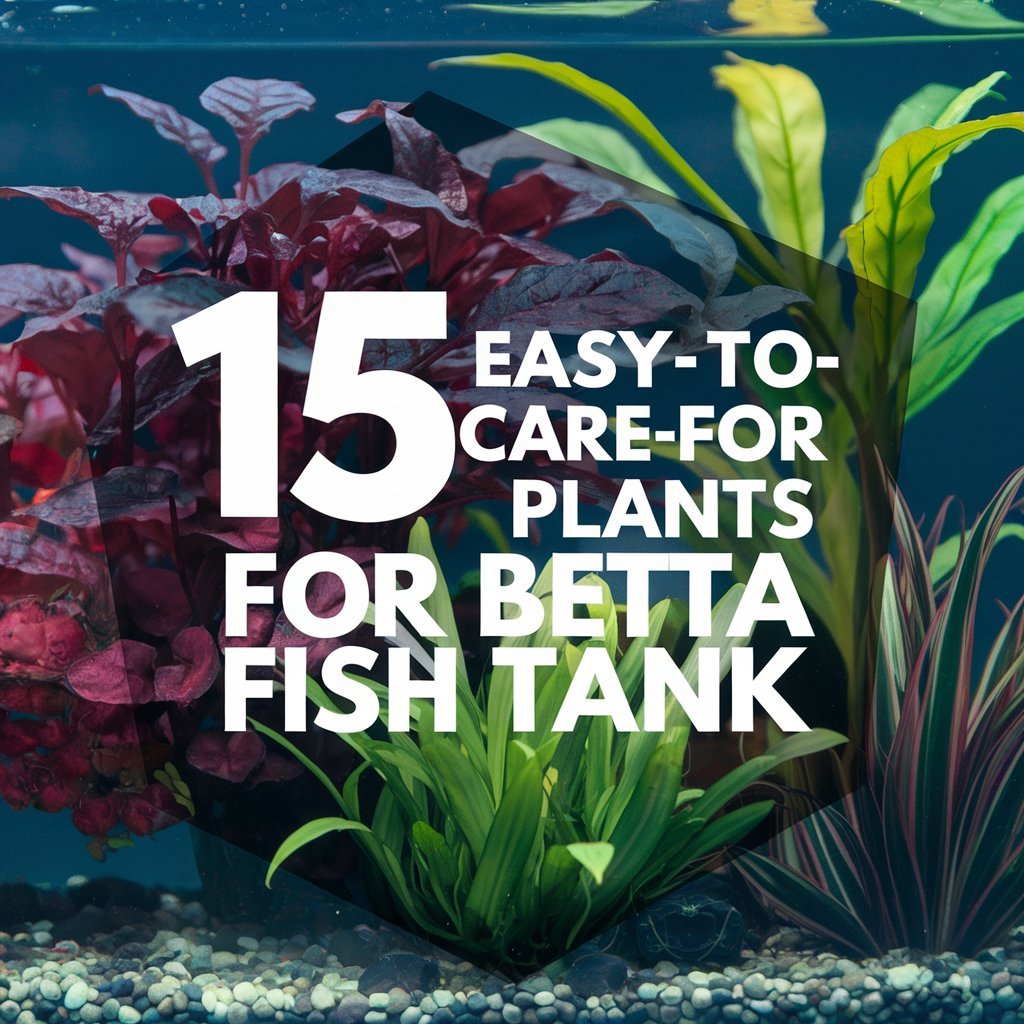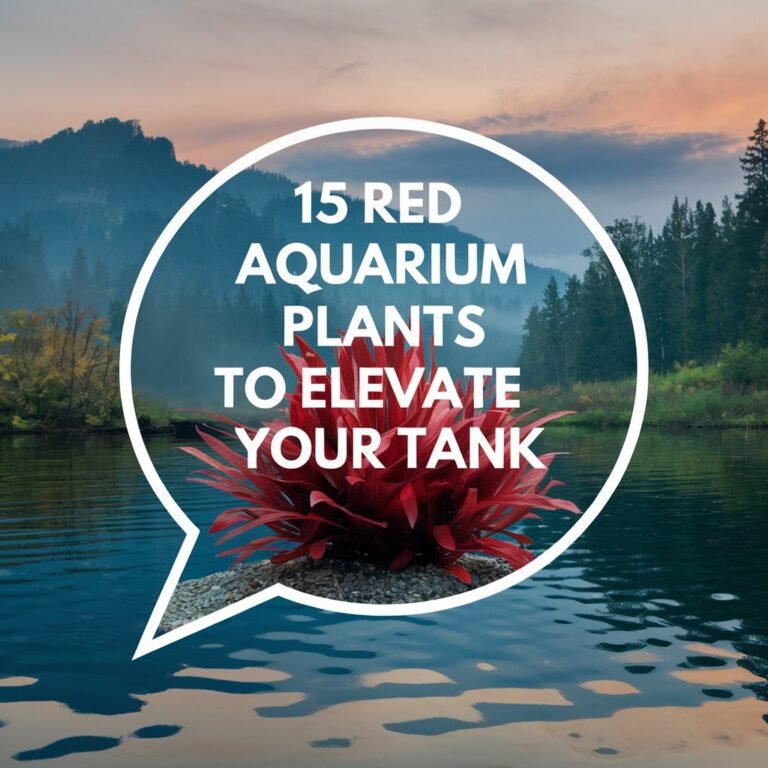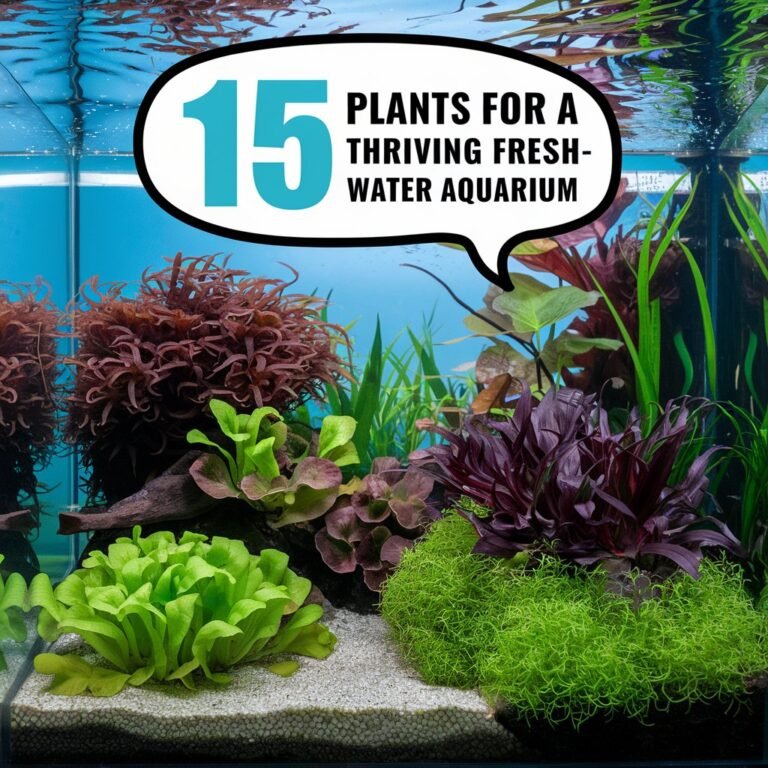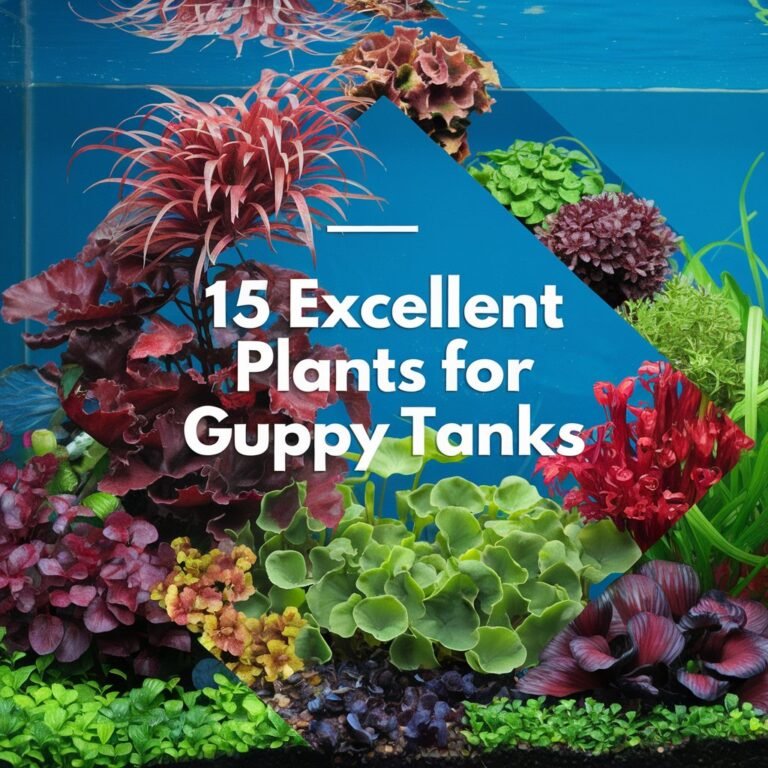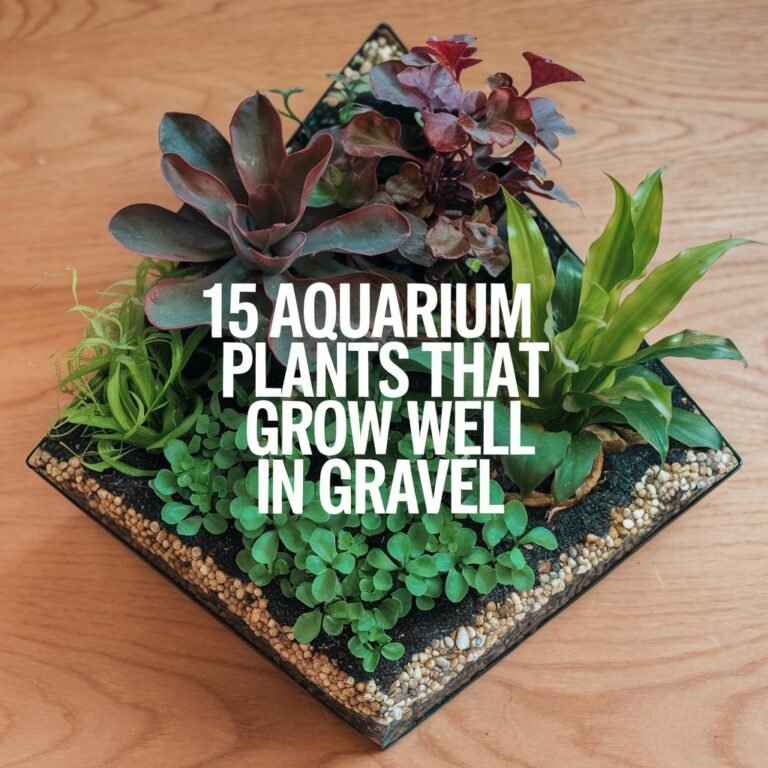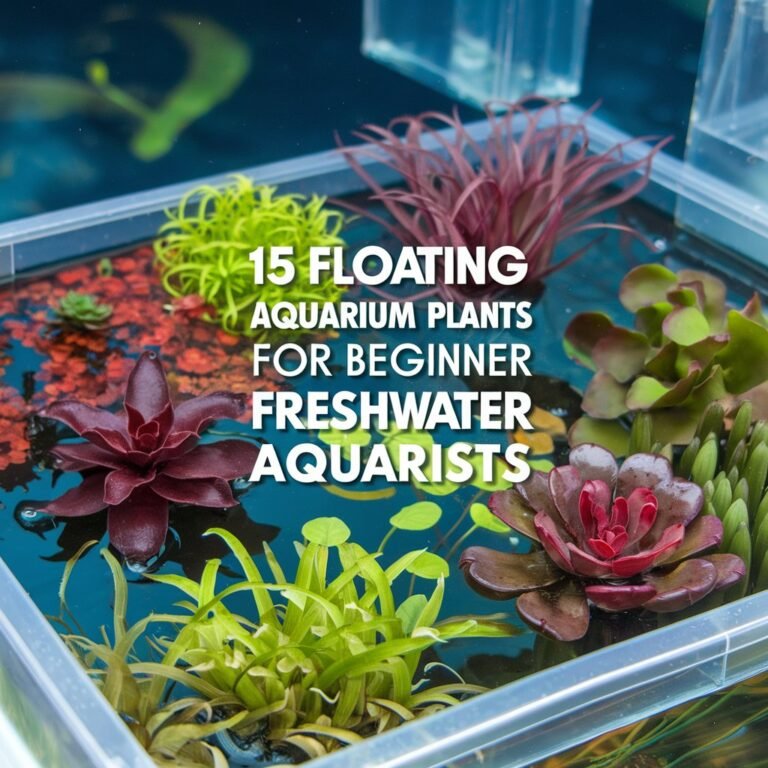15 Easy-to-Care-for Plants for Betta Fish Tank
When you’re looking to elevate your betta fish’s environment, adding plants is a great place to start. But, with so many options available, it can be overwhelming to decide which ones will thrive in your tank.
If you’re new to aquarium gardening, you’re likely looking for low-maintenance plants that won’t add stress to your already busy routine.
You’re in luck – there are many easy-to-care-for options that can bring life and beauty to your tank. But, which ones are the best? Let’s explore the top picks for 2024 and discover the perfect additions to your betta’s home.
In A Nutshell
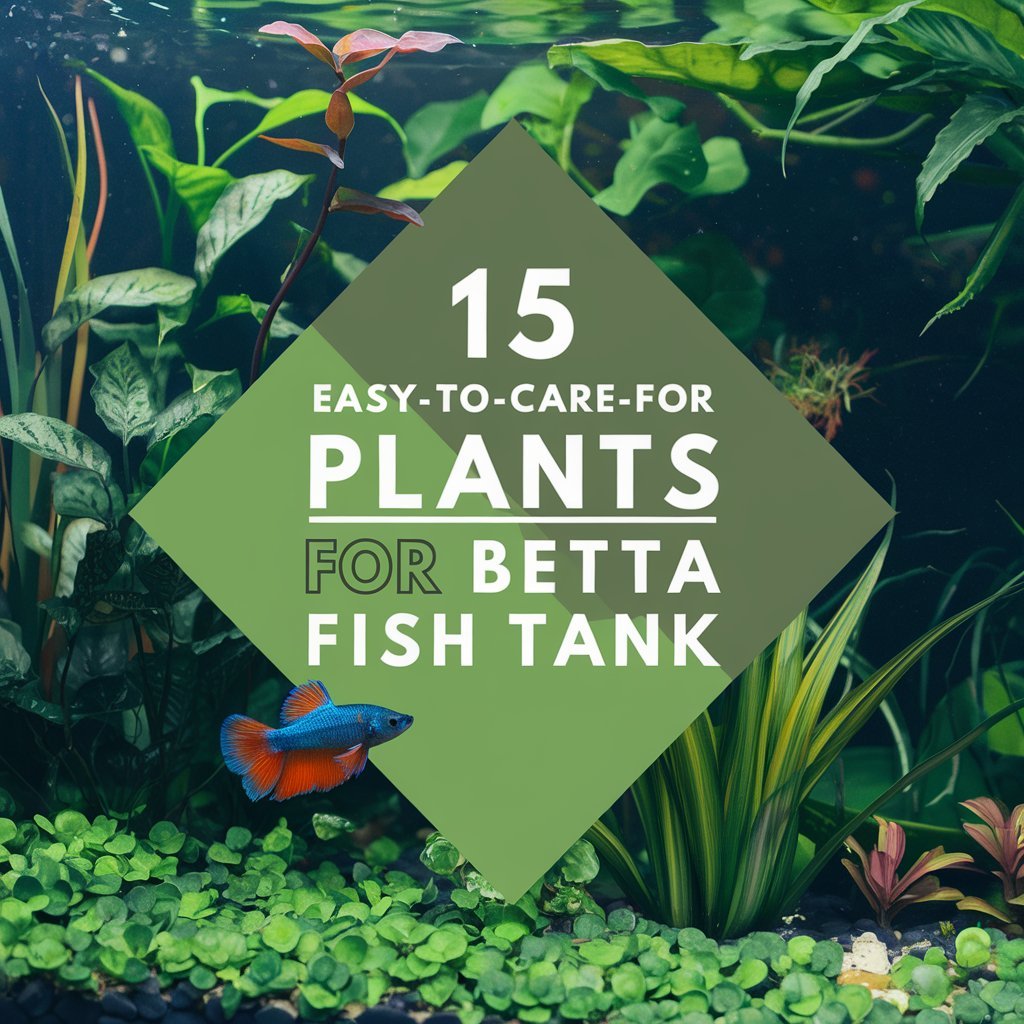
- Java Moss and Hornwort are easy-to-care-for plants suitable for low-maintenance betta fish tanks with low-light conditions.
- Cryptocorynes, Indian Fern, and Guppy Grass are low-maintenance plants that thrive in betta fish tanks with moderate lighting.
- Anacharis, Vallisneria, and Guppy Grass are fast-growing plants that help maintain water quality in betta fish tanks.
- Java Moss, Anacharis, and Water Wisteria provide natural shelter and hiding places for betta fish in the tank.
- Regular water changes, balanced fertilization, and trimming are essential for maintaining the health of plants in a betta fish tank.
Java Moss for Beginners
If you’re new to aquarium plants, Java Moss is an excellent choice for beginners.
It’s easy to care for and can thrive in low-light conditions, making it perfect for betta fish tanks. Java Moss is a versatile plant that can be attached to rocks, driftwood, or other decorations, providing a natural environment for your fish.
When it comes to Moss propagation, Java Moss is a great choice.
It can be easily propagated by cutting a small section of the moss and attaching it to a new surface. This method allows you to quickly spread the moss throughout your tank. Additionally, Java Moss can also be grown on a mesh or a trellis, providing a beautiful display of greenery.
Moss maintenance is also relatively easy.
Java Moss requires regular water changes and a balanced diet of nutrients. You should also trim the moss regularly to keep it healthy and prevent it from overgrowing. With proper care, Java Moss can be a stunning addition to your betta fish tank, providing a natural and beautiful environment for your fish to thrive.
Anacharis the Fast Grower
One of the fastest-growing plants you can add to your betta fish tank is Anacharis. This plant grows at an incredible rate, which can be both beneficial and challenging to manage.
On the plus side, its fast growth benefits include quickly outcompeting algae for nutrients and providing plenty of hiding places for your betta.
As Anacharis grows, it absorbs nutrients from the water, which can have a significant impact on your aquarium’s ecosystem.
By removing excess nutrients, Anacharis helps maintain a balance that prevents algae blooms. This also means you’ll need to monitor your tank’s nutrient levels to guarantee your other plants and fish are getting enough.
To keep Anacharis under control, you’ll need to trim it regularly.
This can be done by simply cutting off sections of the plant with scissors or pruning shears.
You can also propagate new plants by replanting the cut sections.
With proper care and maintenance, Anacharis can thrive in your betta fish tank, providing a lush, natural environment for your fish to enjoy.
Amazon Swords and Betta
Several Amazon Sword species can thrive in a betta fish tank, given the right conditions.
When choosing an Amazon Sword, consider varieties that don’t grow too large, as betta fish tanks tend to be smaller. Echinocorys parviflora, also known as the Dwarf Sword, and Echinocorys tenellus are two suitable options for smaller tanks.
They’re relatively easy to care for, but they still require regular maintenance to prevent overgrowth.
For proper Sword maintenance, you’ll need to trim your plant’s leaves and stems regularly to prevent overgrowth.
This can be done by using aquarium scissors to trim back the plant to about 2-3 inches above the gravel. This helps prevent your betta fish from getting caught in the leaves or having its vision obstructed.
Make sure to leave the plant’s crown intact to allow it to grow new leaves and stems.
When pruning your Sword plant, avoid making any drastic changes that might shock the plant, and try to make cuts at the node.
Water Wisteria Tank Plant
While Amazon Swords can add depth and visual interest to your betta fish tank, they may not be the best choice for every aquarium setup.
If you’re looking for a low-maintenance alternative, consider adding a Water Wisteria tank plant to your aquarium. This versatile, fast-growing plant is perfect for betta fish tanks, as it provides a natural food source and shelter for your fish.
When it comes to Water Wisteria care, you’ll be pleased to know that it’s relatively easy.
This plant thrives in a variety of lighting conditions and can tolerate a range of water temperatures. To keep your Water Wisteria healthy, make sure to provide it with a balanced fertilizer and trim it regularly to prevent overgrowth.
Wisteria propagation is also a breeze.
Simply cut a stem from the mother plant, remove any leaves that will be submerged in water, and plant it in the substrate. With proper care, your new Water Wisteria plant will quickly take root and begin to thrive.
This plant is an excellent choice for betta fish tanks, as it’s easy to care for and provides a natural, beautiful environment for your fish to enjoy.
Low Maintenance Hornwort
Two popular low-maintenance plants often used in betta fish tanks are Water Wisteria and Hornwort.
You’ll find that Hornwort is a great choice for beginners, as it’s easy to care for and can thrive in a variety of conditions.
This floating plant is a natural spawning ground for your betta fish and can help reduce algae growth.
Hornwort propagation is relatively simple.
You can split the stems into smaller sections and tie them together with a thread or a plant weight.
This will allow the plant to grow and spread throughout your tank.
When it comes to Hornwort lighting, you’ll want to provide low to moderate lighting.
Direct sunlight can cause the plant to become scorched, so it’s best to use a low-wattage aquarium light.
In terms of water parameters, Hornwort can tolerate a wide range of temperatures and pH levels.
It’s also a great choice for tanks with low water circulation, as it can help to oxygenate the water.
With proper care, Hornwort can be a beautiful and beneficial addition to your betta fish tank.
Cabomba the Versatile Plant
Cabomba is a versatile plant that can thrive in a variety of aquarium environments, making it an excellent choice for betta fish tanks.
It’s a stem plant that can be grown as a mid-ground or background plant, and its delicate, feathery leaves will add a touch of elegance to your tank. You can easily propagate Cabomba by cutting the stems just above a node, and allowing the cut ends to heal before planting them in the substrate.
Cabomba requires moderate lighting and water circulation to thrive, but it’s relatively easy to care for.
You’ll need to fertilize it regularly to promote healthy growth, and trim it back to maintain its shape. Cabomba pruning is an essential part of its care, as it can become leggy if left untrimmed. By pruning the stems and removing any dead or dying leaves, you can keep your Cabomba plant looking its best.
With proper care and attention, Cabomba can be a stunning addition to your betta fish tank, providing a natural and beautiful environment for your fish to thrive.
Enhance With Indian Fern
One of the most attractive and easy-to-care-for plants you can add to your betta fish tank is the Indian Fern.
This plant is perfect for adding a touch of Indian decor inspiration to your aquarium. With its delicate, lacy fronds, the Indian Fern creates a beautiful, natural environment for your betta fish to thrive in.
To keep your Indian Fern healthy and thriving, you’ll want to provide it with the right lighting.
Fern lighting tips include using low to moderate lighting, as direct sunlight can cause the fronds to become scorched. You can also use LED aquarium lights, which provide a balanced spectrum of light that promotes healthy plant growth.
When planting your Indian Fern, make sure to anchor the rhizome to a rock or driftwood to prevent it from floating away.
You can also attach it to the side of the tank using a plant clip. With proper care and maintenance, your Indian Fern will grow and flourish, creating a stunning display of greenery in your betta fish tank.
Betta Friendly Cryptocorynes
If you’re looking for more variety in your betta fish tank’s plant life, consider adding some Cryptocorynes. These plants are great for beginners, as they’re relatively low maintenance and can thrive in a range of water conditions.
There are over 70 different Cryptocoryne varieties to choose from, each with unique leaf shapes, sizes, and colors. Some popular varieties include Cryptocoryne wendtii, Cryptocoryne parva, and Cryptocoryne spiralis.
When choosing a Cryptocoryne variety, consider the lighting and water conditions in your tank. Some Cryptocorynes prefer bright lighting, while others can tolerate lower light levels.
Cryptocorynes also prefer slightly acidic to neutral water pH, with temperatures between 72-82°F (22-28°C).
Cryptocoryne propagation is relatively easy. You can propagate these plants by dividing the rhizome, which is the thick stem that produces new leaves and roots.
Simply cut the rhizome into sections, making sure each section has at least one growing point. Plant the sections in the substrate, and keep the water conditions stable.
With proper care, your Cryptocorynes will thrive and add variety to your betta fish tank.
Growing Water Sprite Plants
Water Sprite plants are a popular choice for betta fish tanks due to their versatility and low-maintenance requirements.
You can grow them floating on the surface, attached to driftwood, or rooted in the substrate. This flexibility makes them a great option for creating a unique aquascape.
For ideal Water sprite care, you’ll want to provide them with moderate to high lighting, as they require a lot of energy to grow.
You’ll also want to maintain a pH between 6.5 and 7.5, and water temperatures between 72°F and 82°F. Regular water changes are essential to keep your Water Sprite plants healthy and thriving.
Water sprite propagation is relatively easy.
Simply trim off a healthy stem, and replant it in the substrate.
You can also propagate them by separating the roots of a mature plant and replanting the sections.
With proper care and attention, your Water Sprite plants will quickly spread and create a lush, green environment for your betta fish to enjoy.
Adding Anubias to Tanks
As you’re setting up or updating your betta fish tank with a variety of low-maintenance plants, Water Sprite isn’t the only great option for a beautiful, lush environment.
You may also consider adding Anubias to your tank, a genus of aquatic plants known for their versatility and ease of care. With over 60 Anubias species, you’ll have plenty of options to choose from, including popular varieties like Anubias barteri, Anubias nana, and Anubias congensis.
When it comes to Anubias care tips, you’ll want to keep in mind that these plants prefer well-oxygenated water and moderate lighting.
They can thrive in a variety of water conditions, but ideally, you’ll want to maintain a pH between 6.5 and 8.5.
Anubias plants also prefer to be attached to rocks or driftwood, rather than planted in the substrate.
To promote healthy growth, make sure to provide your Anubias plants with a balanced fertilizer and regular pruning.
With proper care, Anubias plants can be a stunning addition to your betta fish tank, providing a natural and beautiful environment for your fish to thrive.
Vallisneria for the Aquarium
Vallisneria, one of the most popular aquarium plants, is a versatile and attractive choice for your betta fish tank.
It’s easy to care for and can be used in a variety of Vallisneria aquarium designs, from simple to complex.
When it comes to Vallisneria care tips, you’ll want to provide it with plenty of light, as it’s a fast-growing plant that thrives in well-lit conditions.
It can tolerate a range of water temperatures, from 72°F to 82°F, making it suitable for most betta fish tanks.
To keep your Vallisneria healthy, make sure to provide it with a nutrient-rich substrate and regular water changes.
You can also trim it regularly to maintain its shape and promote healthy growth.
Vallisneria can grow quite tall, so you may need to prune it to prevent it from overwhelming your tank.
With proper care, Vallisneria can be a beautiful and thriving addition to your betta fish tank.
It’s a great choice for beginners and experienced aquarists alike, and can add a touch of elegance to any aquarium design.
Benefits of Java Ferns
While choosing the perfect plants for your betta fish tank, you may find yourself looking for alternatives to Vallisneria or complementing it with another plant.
Java Ferns are an excellent option to weigh. They’re easy to care for, adaptable, and add a unique touch to your aquarium decor.
Java Ferns can thrive in low-light conditions, making them suitable for tanks with limited lighting. They’re also great for creating hiding spots and visual interest for your betta fish.
Java Fern Propagation is relatively easy and can be done by tying the rhizome to a rock or driftwood. This will allow the fern to grow and create a natural, lush environment in your tank.
As the fern grows, you can trim it to maintain the desired shape and size. Java Ferns are also great for decorating your tank, adding a delicate, tropical feel to the aquatic environment.
With proper care, Java Ferns can be a valuable addition to your betta fish tank, providing a healthy and thriving environment for your fish. By incorporating Java Ferns into your aquarium decor, you can create a unique and visually appealing environment.
Easy to Care for Guppy Grass
Guppy Grass, also known as Najas grass, is a fast-growing, versatile plant that can be a fantastic addition to your betta fish tank.
You’ll find that it’s relatively easy to care for, making it perfect for beginners. One of the main Guppy grass benefits is its ability to provide shelter and food for your betta fish.
It’s also a great natural filter, helping to keep your tank clean and healthy.
When it comes to Guppy grass propagation, you’ll find that it’s a relatively straightforward process.
Simply cut the stems of the plant, leaving about an inch at the base, and replant them in your tank.
You can also propagate Guppy grass by separating the roots, making it easy to share with friends or expand your own collection.
To keep your Guppy grass thriving, make sure it’s receiving plenty of light.
It can tolerate a range of lighting conditions, but it will do best in medium to high light.
Regular water changes and a balanced fertilizer will also help to keep your Guppy grass healthy and strong.
Planting Ludwigia in Tanks
With Najas grass providing an excellent natural filter for your betta fish tank, you may want to ponder complementing it with other easy-to-care-for plants like Ludwigia.
Ludwigia is a versatile, adaptable plant that can thrive in a variety of tank conditions. It’s relatively easy to care for, requiring moderate lighting and regular water changes. Ludwigia care involves maintaining a pH range of 6.0-8.0 and water temperatures between 72-82°F (22-28°C).
When it comes to Ludwigia propagation, you can easily propagate the plant by cutting the stems just above a node. This will encourage new growth and help the plant spread throughout the tank.
You can also propagate Ludwigia by separating the roots of mature plants. Ludwigia can be planted in the mid-ground or background of the tank, where it can grow up to 20 inches tall.
Regular pruning will help keep the plant under control and promote healthy growth. By following these simple care and propagation guidelines, you can enjoy the benefits of Ludwigia in your betta fish tank.
Ludwigia’s vibrant colors and delicate texture make it a great addition to any aquarium.
Styling With Dwarf Hairgrass
Dwarf Hairgrass is another popular aquatic plant that can add a beautiful, lush carpet to your betta fish tank.
By incorporating it into your aquarium, you’ll achieve stunning grass coverage and an increased sense of depth. When properly planted and maintained, Dwarf Hairgrass forms a dense mat of vibrant green blades, which not only beautifies the space but also creates an excellent environment for your betta to swim through.
One key advantage of Dwarf Hairgrass is its versatility – you can either use it to cover large areas of your tank or shape it to fit into more compact spaces.
By placing rocks, driftwood, or other decorations in between the hairgrass, you create a unique, eye-catching display of aquatic contrast that brings the aquarium to life.
For the most impressive results, keep in mind that Dwarf Hairgrass prefers slightly acidic water conditions, as well as adequate lighting – which may range from medium to high levels of intensity, depending on the type of light used in your aquarium.
Frequently Asked Questions
Can I Use a Single Plant Species in My Betta Tank?
You can use a single plant species in your betta tank, but be cautious of plant dominance. A single specimen can thrive, but if not balanced, it may outcompete other species or overwhelm the tank’s ecosystem.
How Often Should I Trim My Tank Plants?
You’ll want to trim your tank plants regularly, ideally every 1-2 weeks, to maintain shape and promote growth. Establish a pruning schedule and stick to it, using plant clipping to control length and encourage healthy development.
Can Betta Fish Eat All Aquarium Plants?
You shouldn’t assume all aquarium plants are safe for your betta fish to eat. Some plants provide essential plant nutrition, but many aren’t fish-safe. Research each plant to guarantee they’re non-toxic and suitable for your betta’s consumption.
How Long Does It Take for Plants to Adjust to Tank Water?
When introducing plants to your tank, you’ll notice they take around 1-4 weeks to adjust to the tank water through a process called Water Acclimation, which complements the tank’s Cycling Process, ensuring a healthy environment.
Do All Aquarium Plants Require a Separate Growing Substrate?
You don’t necessarily need a separate substrate for aquarium plants, as many thrive in the same gravel as your betta fish. Aquatic mediums and soil alternatives, like fluorite or clay-based options, offer alternatives for plants with unique needs.
FInal Verdict
You’ve now explored the top easy-to-care-for plants for your betta fish tank. From low-maintenance options like Java Moss and Hornwort to fast-growing plants like Anacharis and Guppy Grass, there’s something for every aquarist.
By incorporating these plants, you’ll create a thriving environment that provides shelter, food, and natural beauty for your betta. With proper care, these plants will bring life and vibrancy to your tank, making it a stunning underwater world.

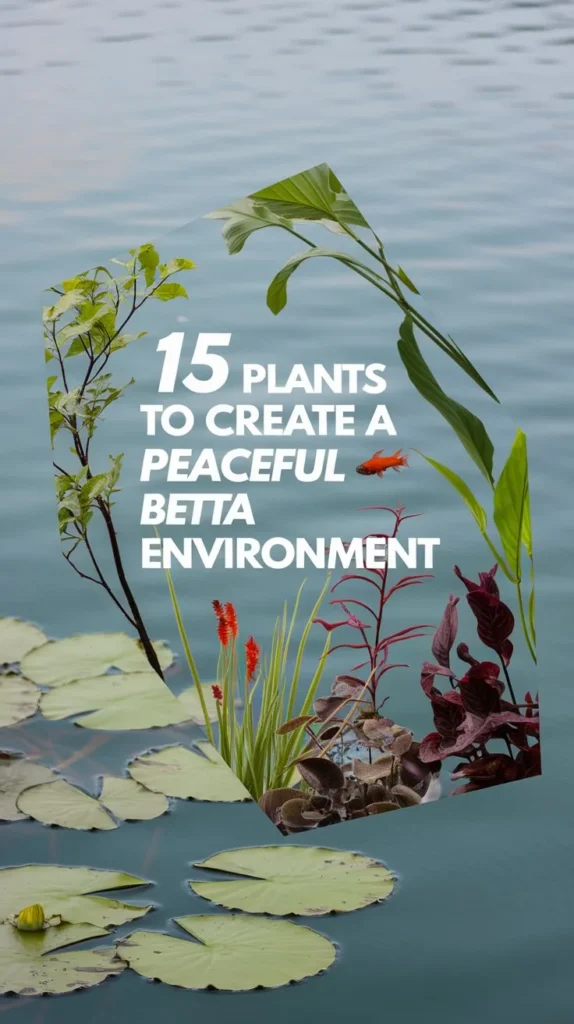

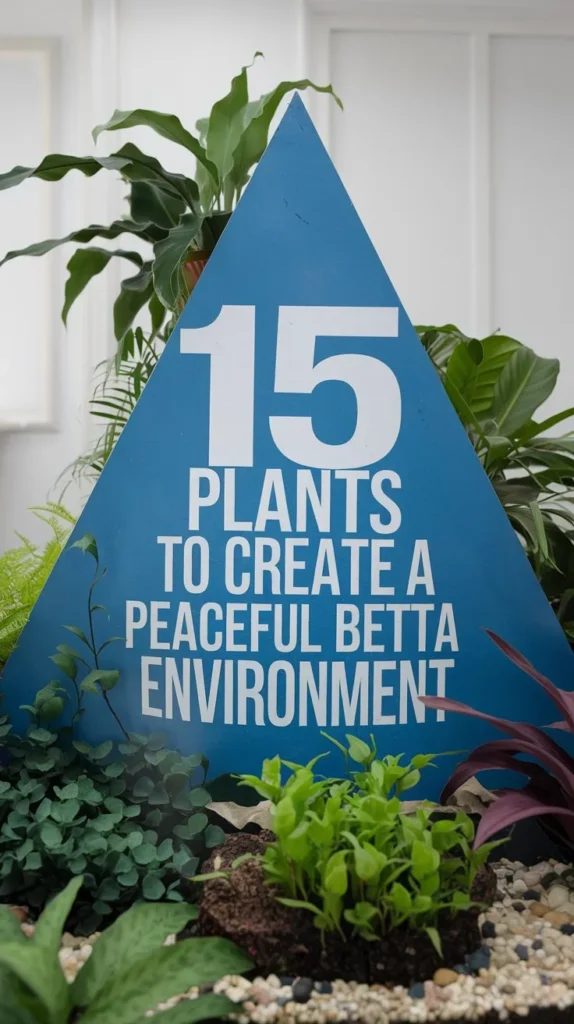

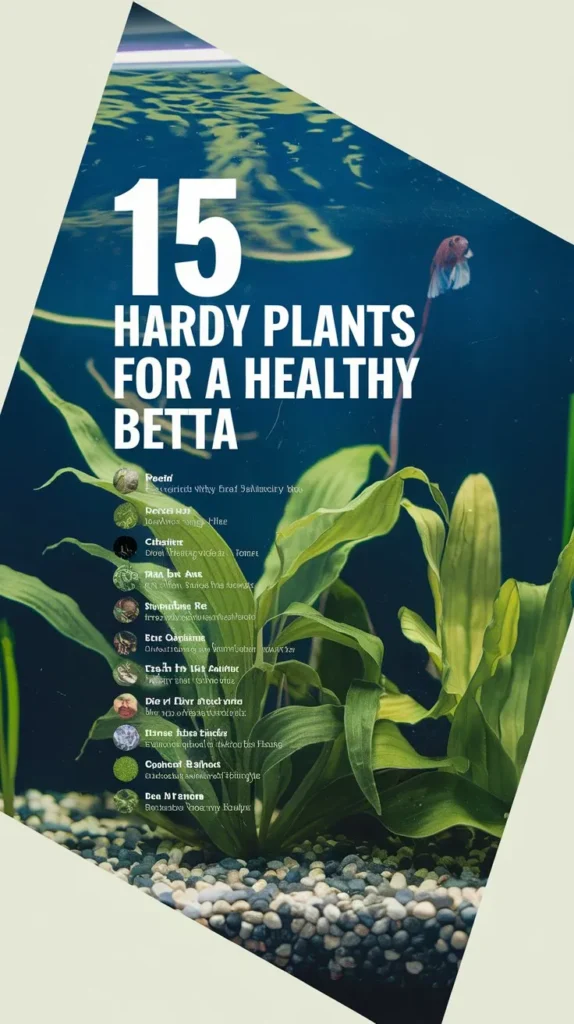
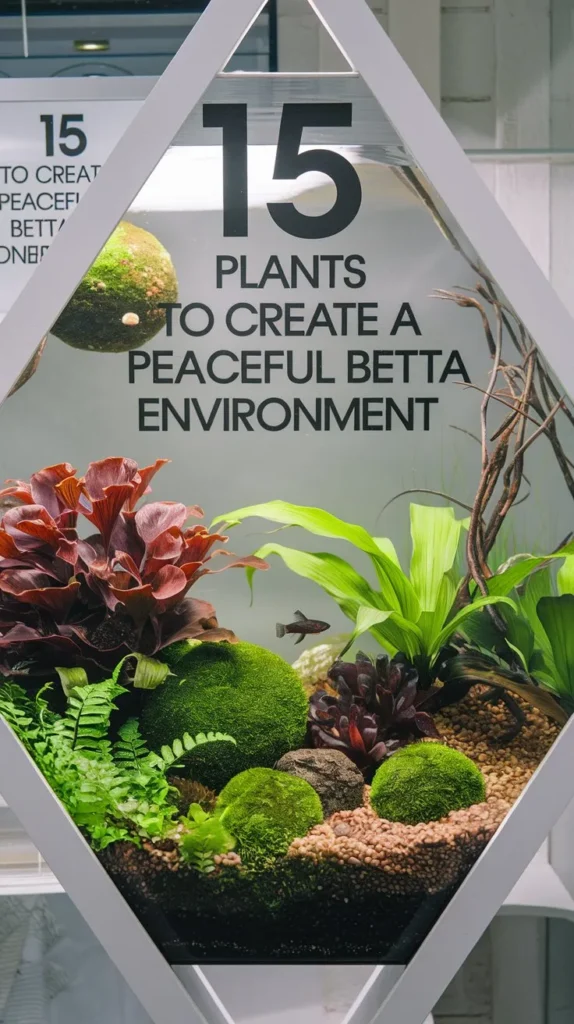


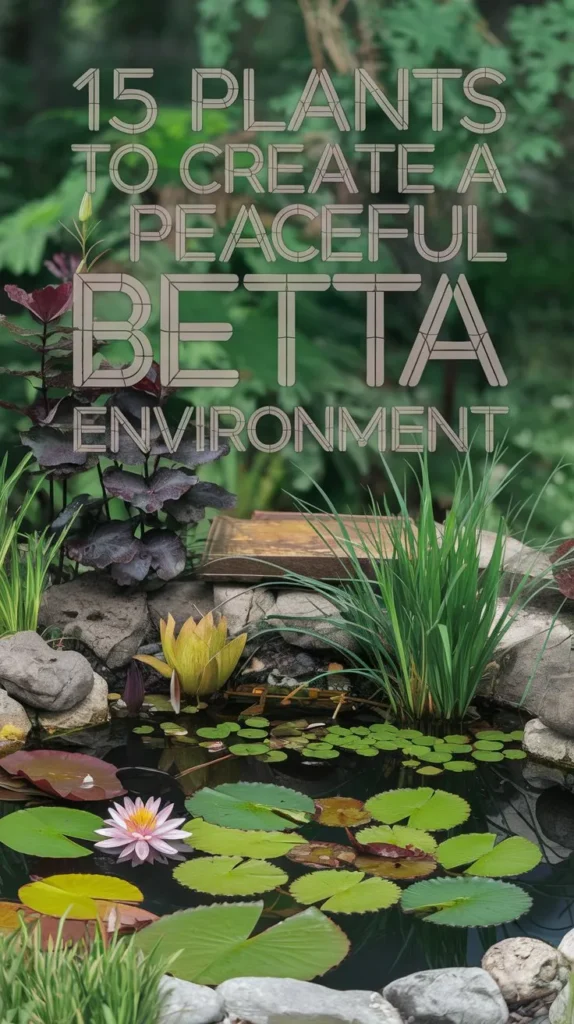


Hello, I’m Aria Cooper, the heart and soul behind Swimmy Buddies. As a devoted fish aficionado, I share my aquatic adventures and expertise to inspire your own underwater explorations. 🐠🌊

